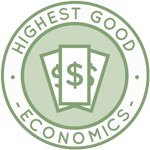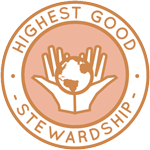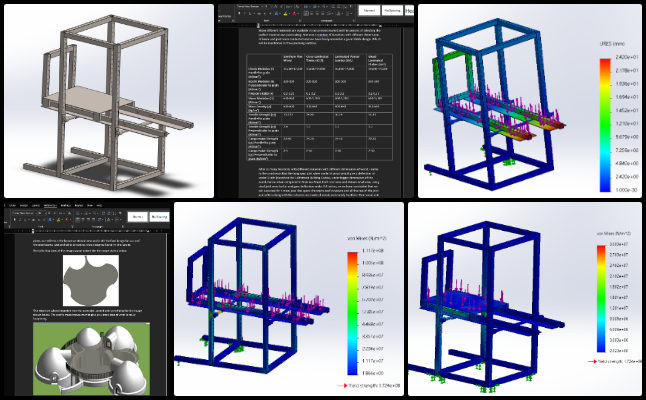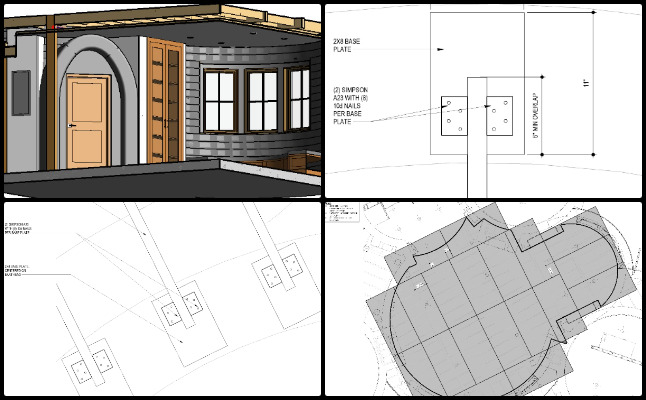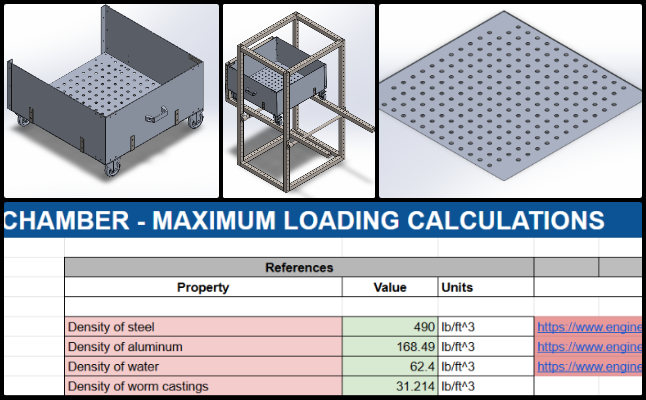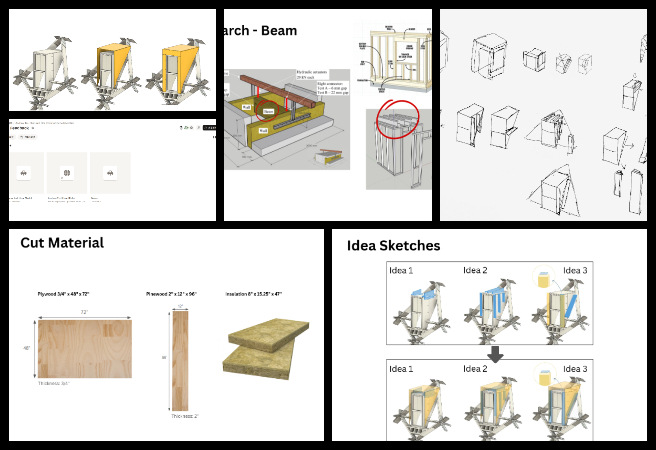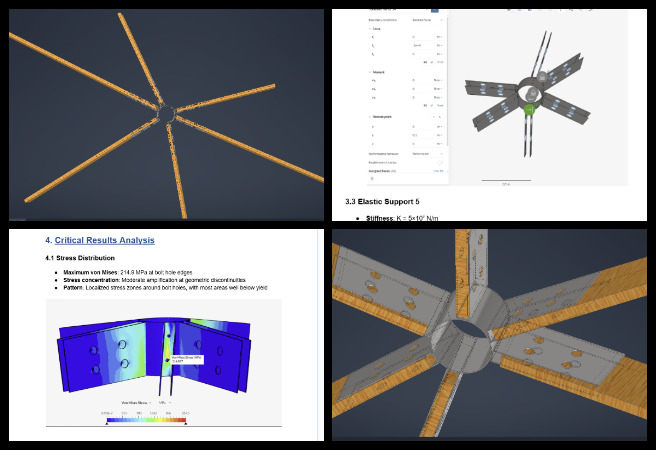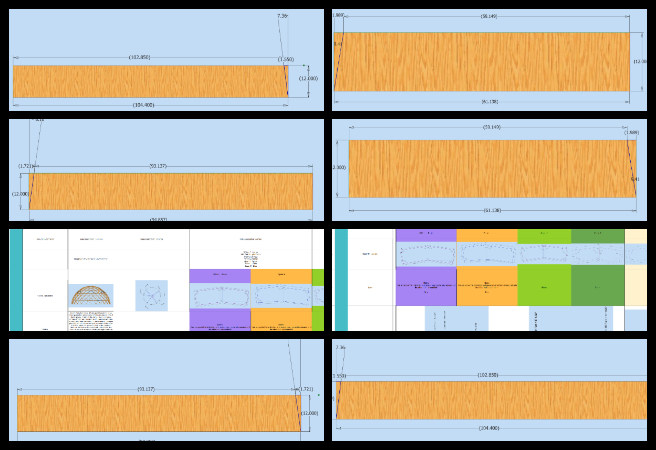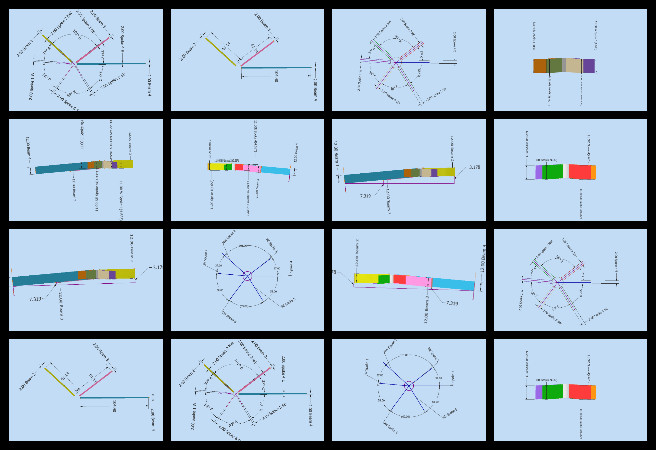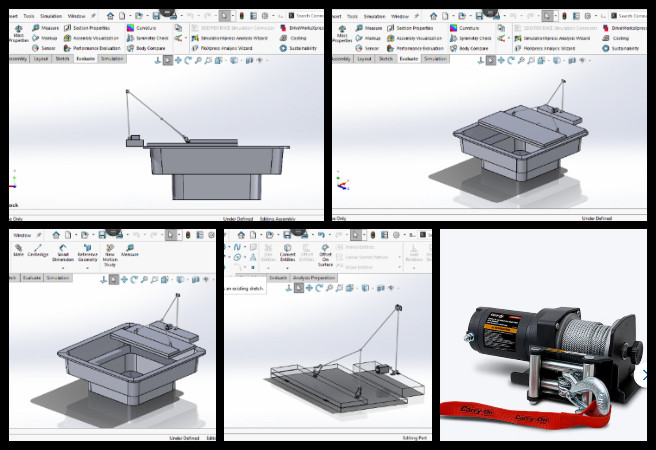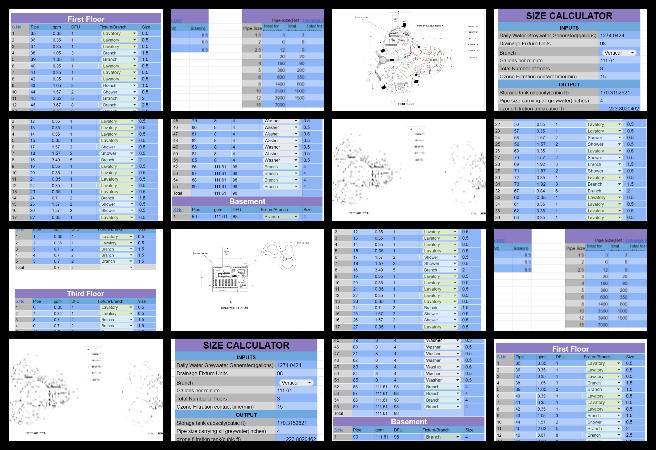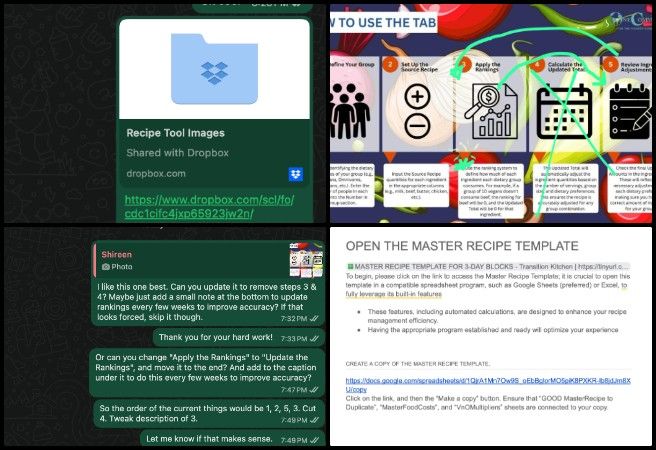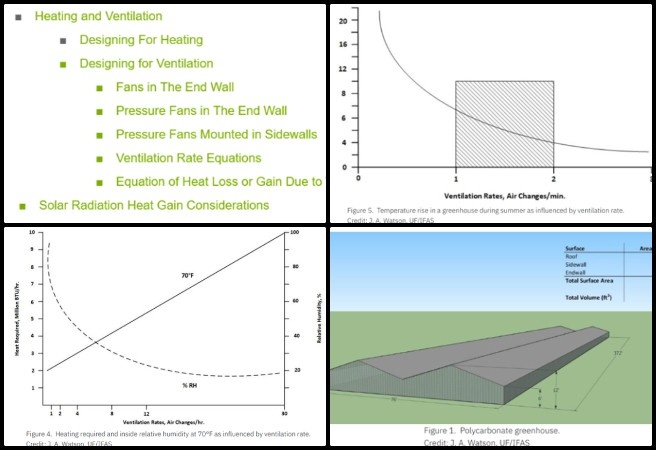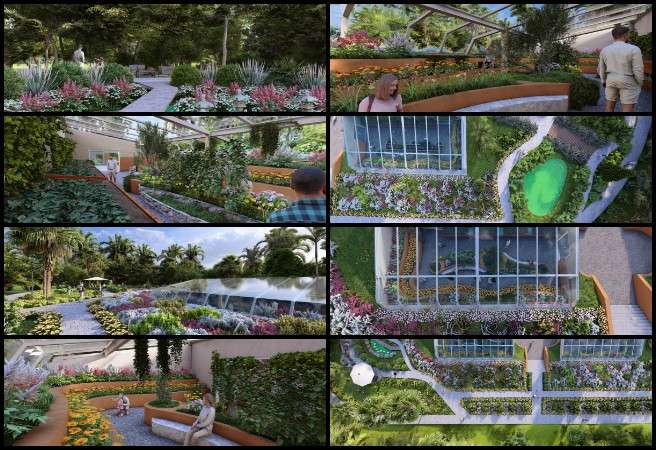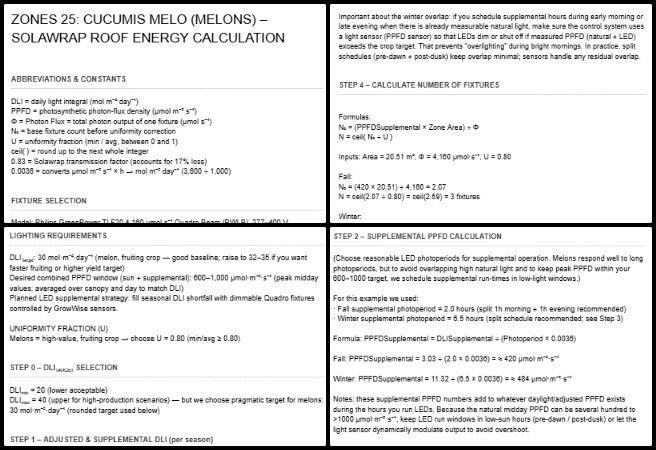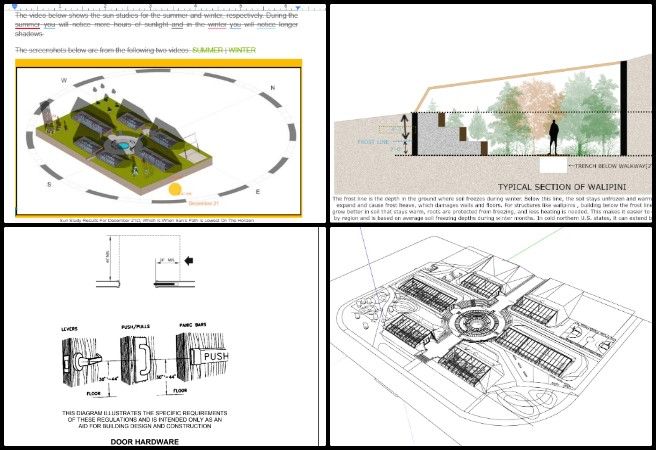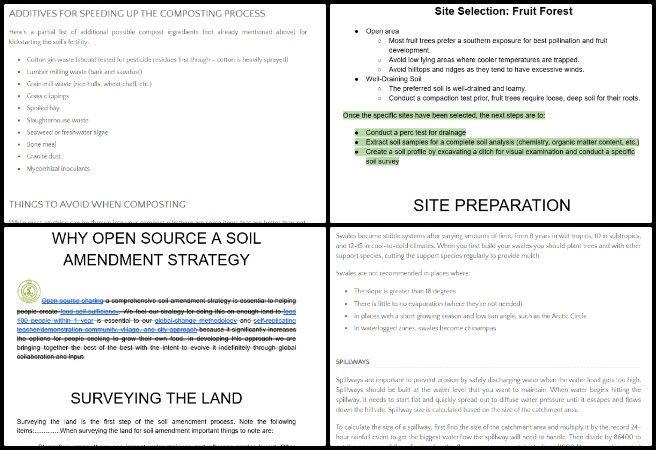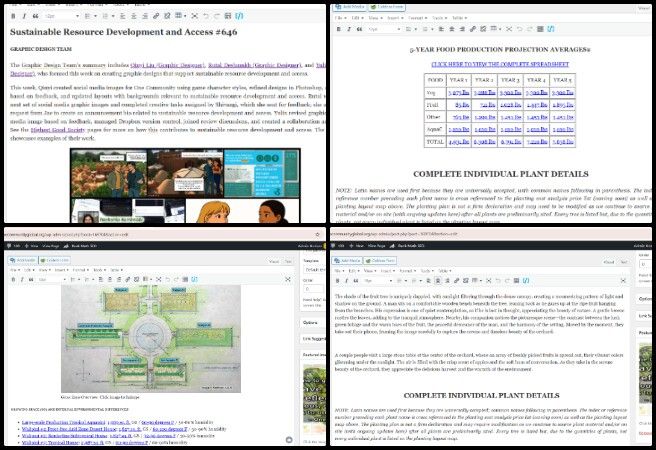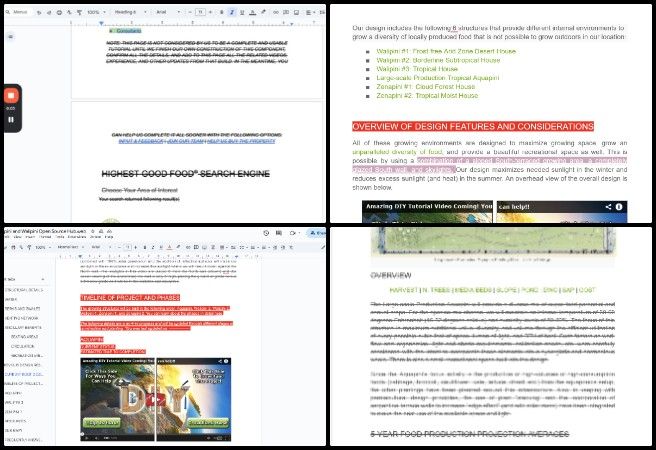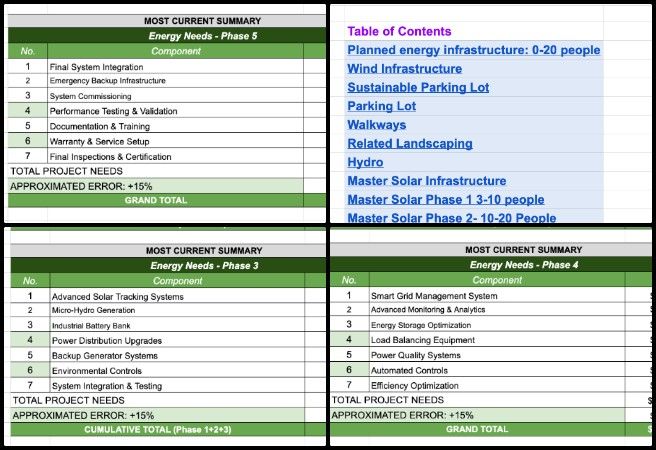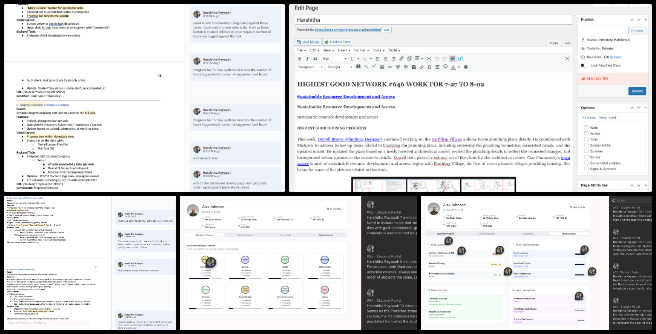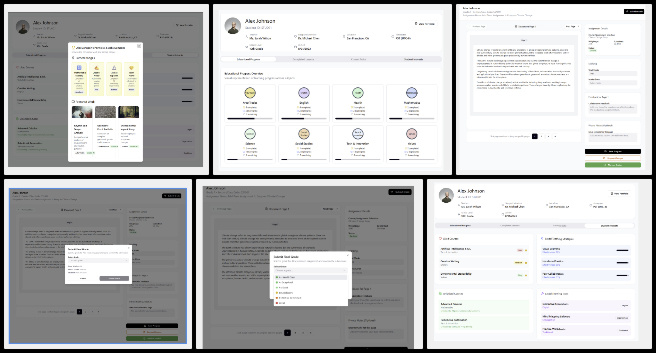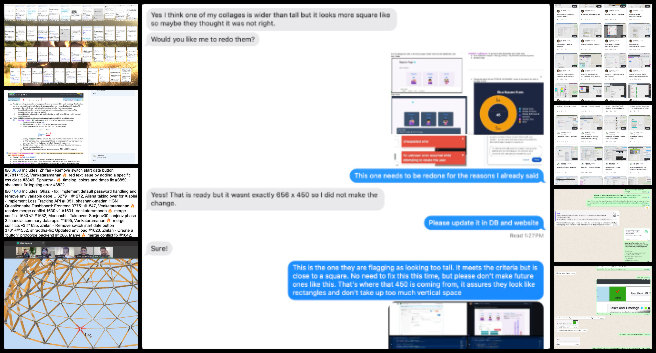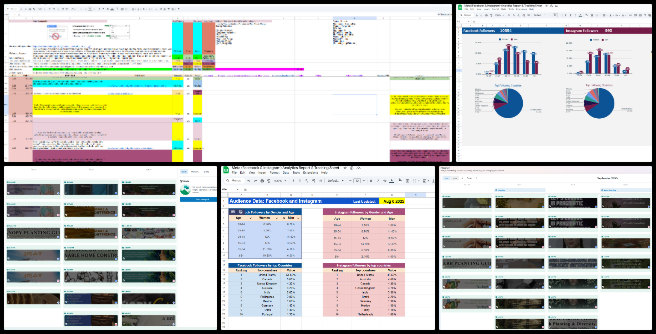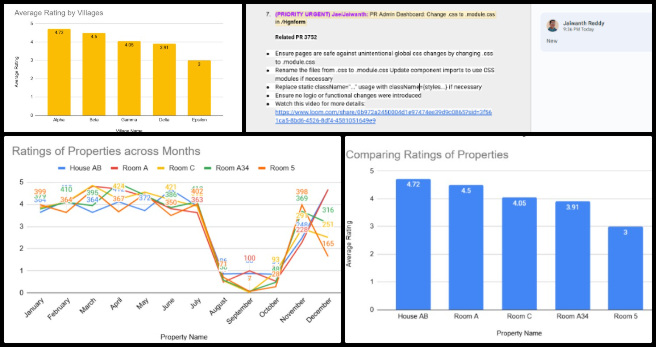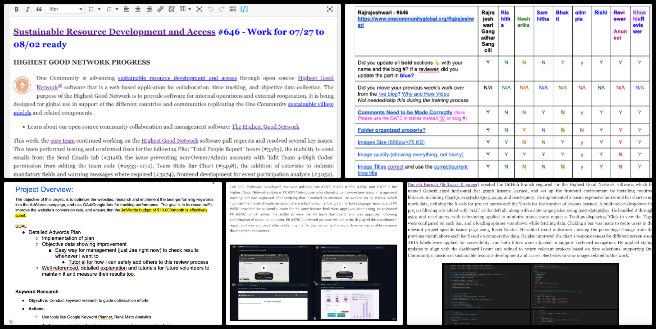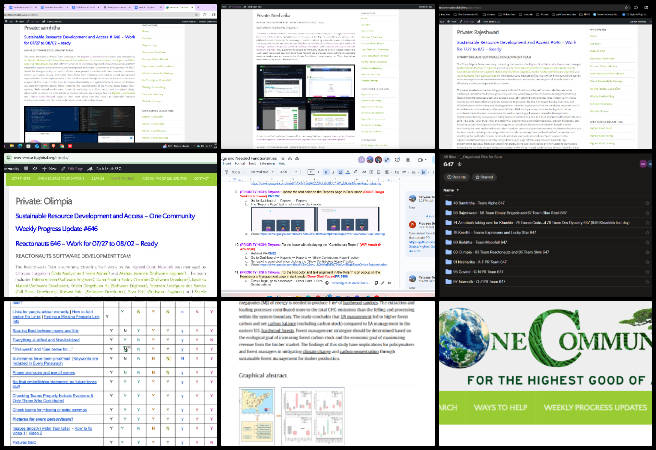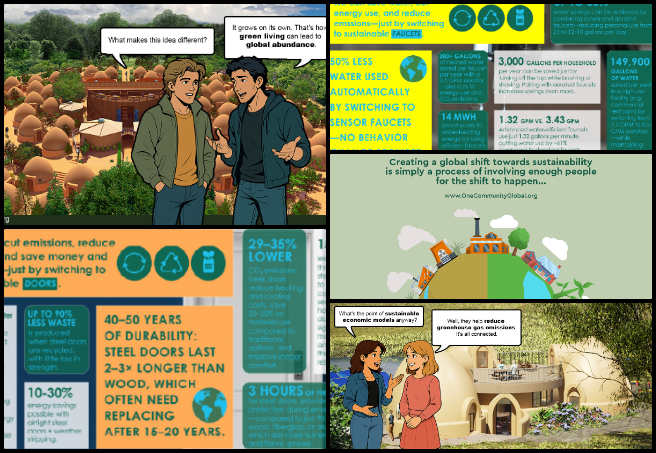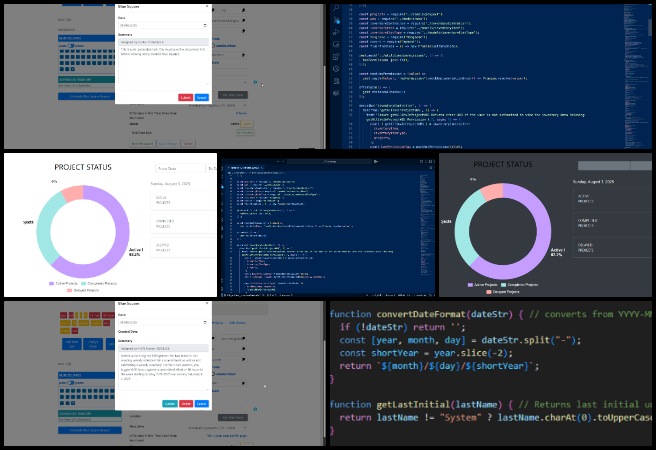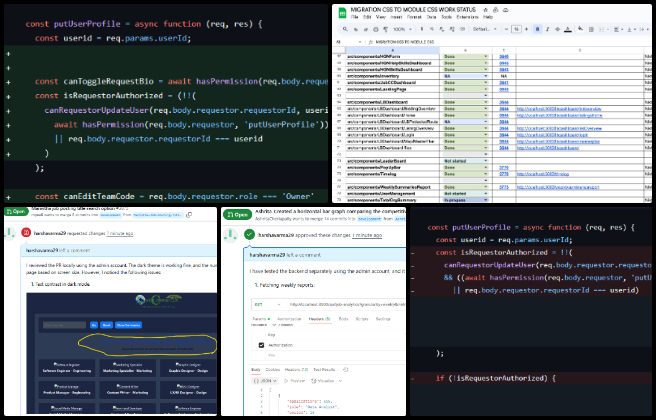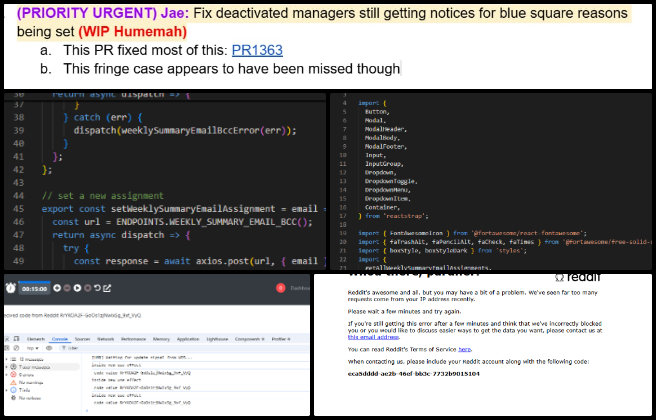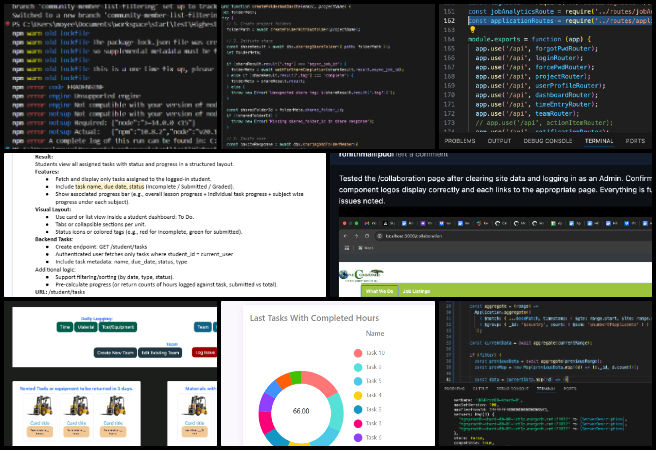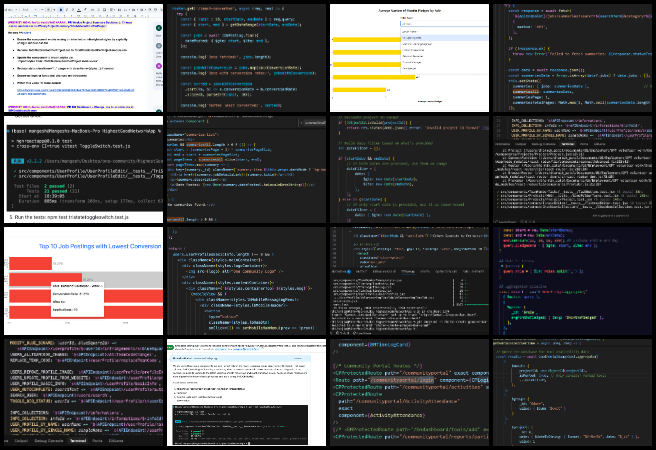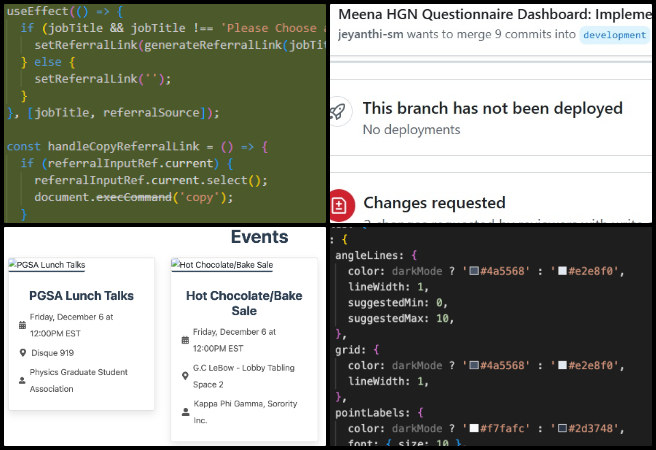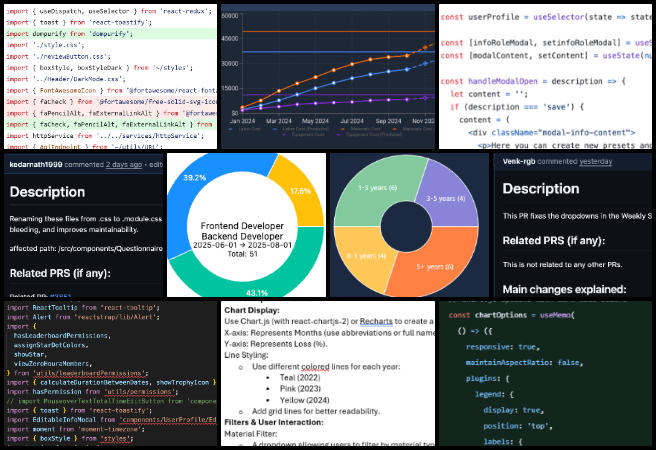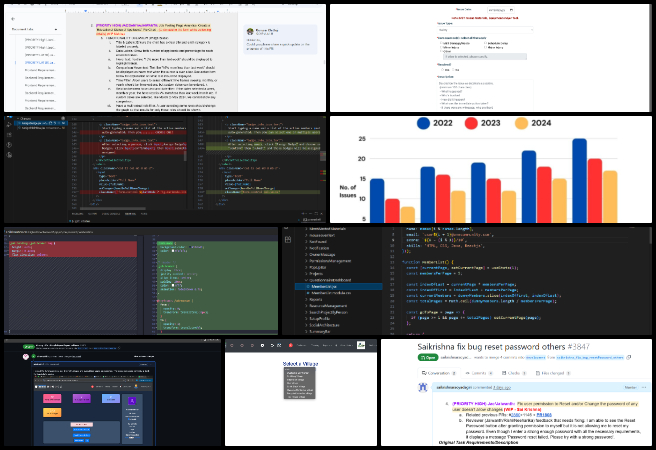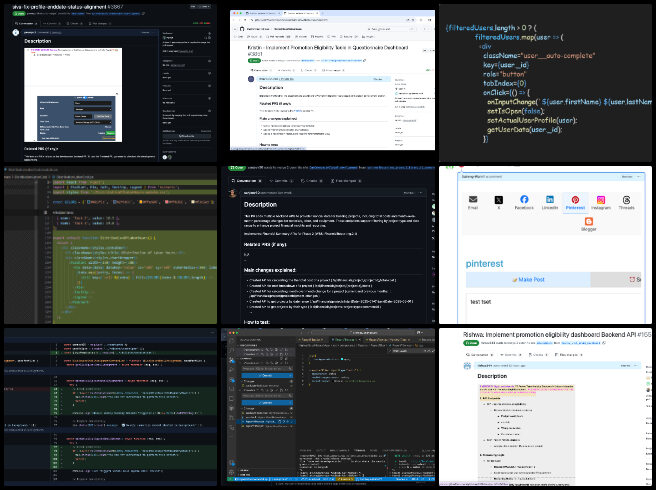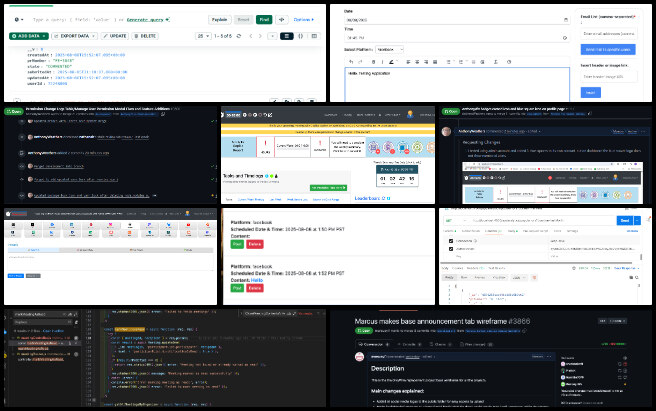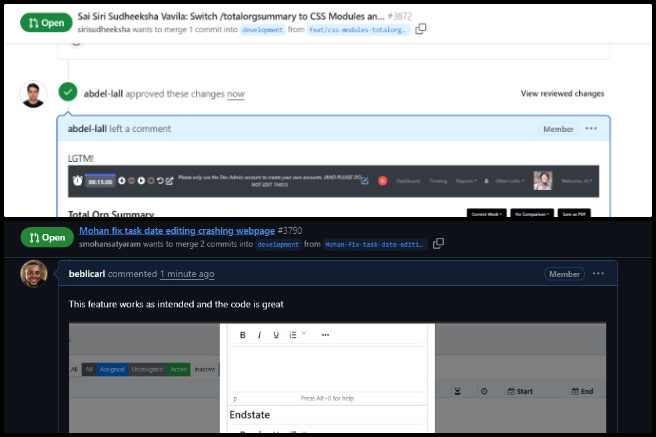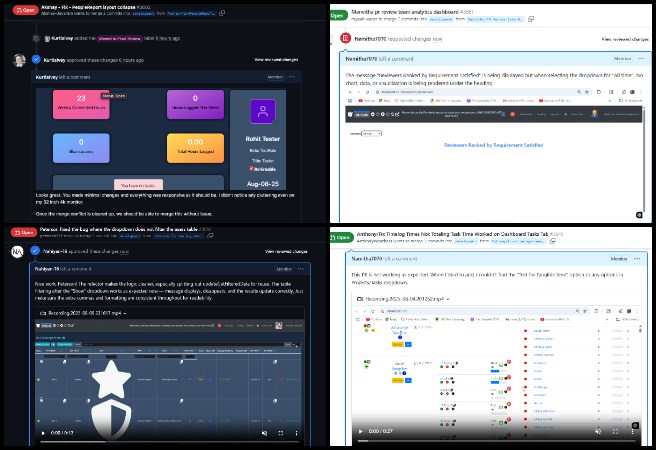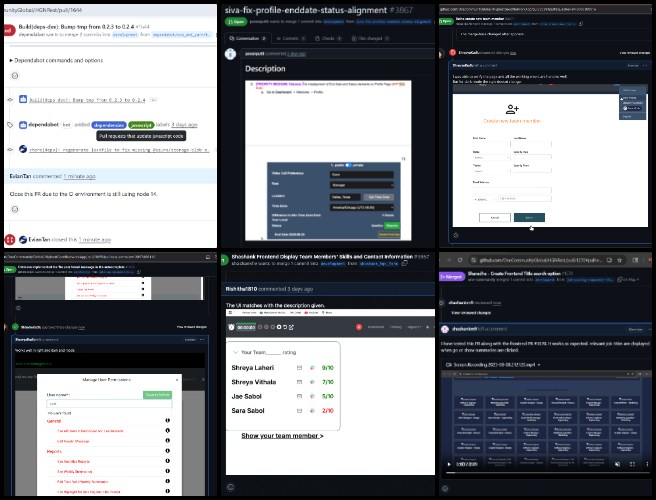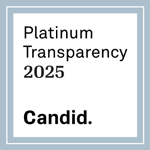Creating an Ecological Living Paradigm – One Community Weekly Progress Update #647
At One Community, we are creating an ecological living paradigm by open sourcing and free sharing the complete process of sustainable approaches to food, energy, housing, education, economics, social architecture, and more. Created by an all-volunteer team, our work is designed to be self-replicating and support a global collaboration of teacher/demonstration hubs. Together, we are evolving sustainability and regenerating our planet while building a world that works for everyone. Everything we do is for The Highest Good of All, and we invite others to join us in this global movement toward a thriving and inclusive future.
- Here’s our project overview
- Here’s our world-change methodology
- Here’s how this becomes self-replicating
- Here’s how we are open source and free-sharing all the do-it-yourself designs
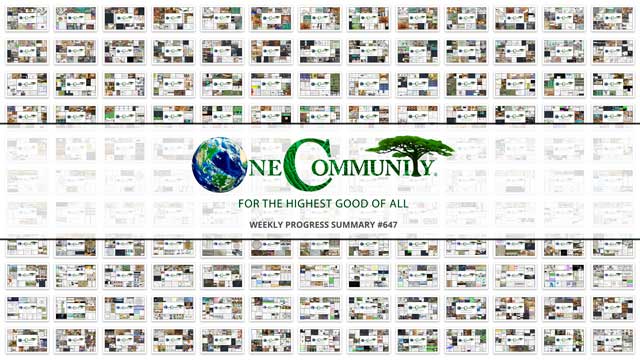
OUR MAIN OPEN SOURCE HUBS
Click on each icon to be taken to the corresponding Highest Good hub page.
One Community’s physical location will forward this movement as the first of many self-replicating teacher/demonstration communities, villages, and cities to be built around the world. This is the August 11, 2025 edition (#647) of our weekly progress update detailing our team’s development and accomplishments:
Creating an Ecological Living Paradigm
One Community Progress Update #647
DONATE | COLLABORATE | HELP WITH LARGE-SCALE FUNDING
CLICK HERE IF YOU’D LIKE TO RECEIVE AN EMAIL EACH WEEK WHEN WE RELEASE A NEW UPDATE
YOU CAN ALSO JOIN US THROUGH SOCIAL MEDIA
ONE COMMUNITY WEEKLY UPDATE DETAILS
HIGHEST GOOD HOUSING PROGRESS
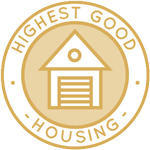 One Community is creating an ecological living paradigm through Highest Good housing that is artistic and beautiful, more affordable, more space efficient, lasts longer, DIY buildable, and constructed with healthy and sustainable materials:
One Community is creating an ecological living paradigm through Highest Good housing that is artistic and beautiful, more affordable, more space efficient, lasts longer, DIY buildable, and constructed with healthy and sustainable materials:
- Learn about: Our Upcoming Crowdfunding Campaign
- Learn about the different village models: 7 Sustainable Village Models
- Visit the open source portals for the first two: Earthbag Village OS Hub | Straw Bale Village OS Hub
This week, Derrell Brown (Plumbing Designer) continued working on the Earthbag Village 4-dome home plumbing plans details. He coordinated with Michaela to address follow-up items related to finalizing the plumbing plans, including reviewing the plumbing isometrics, associated details, and the updated model. He updated the plans based on a newly received architectural model, revised the plumbing details to reflect the requested changes, and incorporated minor updates to the isometric details. Derrell began working on the final report by gathering information used in the project. One Community’s open source launch of creating an ecological living paradigm begins with Earthbag Village, the first of seven planned villages providing housing. See below for some of the pictures related to this work.
Karthik Pillai (Mechanical Engineer) continued working on the Vermiculture Toilet project, focusing on the waste dumping mechanism and performing FEA to evaluate the structural integrity and confirm that the design meets safety requirements. He also coordinated with Rahul, explaining the current progress, clarifying the project objectives, and outlining the specific tasks he will be responsible for. In parallel, for the Earthbag Village 4-dome cluster roof design, Karthik completed additional FEA iterations to validate the structural safety of the existing design and reviewed Michaela’s findings to confirm the design meets the necessary safety criteria. He has also started the final project report to document the analysis and findings. As the first of seven planned villages, the Earthbag Village provides the initial housing within One Community’s open source designs for creating an ecological living paradigm. See the work in the collage below.
Ketsia Kayembe (Civil Engineer) continued working on the three domes of the Earthbag Village and prepared the AutoCAD files for construction use for the three domes of the Earthbag Village. She focused on editing the floor plan drawings by gathering relevant information from the construction template and other related files. She updated the drawings to reflect the required changes and organized the files with appropriate names. Ketsia reviewed the construction template to ensure the edits aligned with the stated requirements and instructions. One Community’s open source framework on creating an ecological living paradigm begins with Earthbag Village, the first of seven planned villages providing housing. See below for some of the pictures related to this work.
Michaela Silva (Architect) continued working on fine tuning details in the construction documents of the Earthbag Village. She finalized the MEP documents with the engineer and added details to the architectural construction documents. She created a living room ceiling detail to show the optimal gypsum board layout based on light locations and the ceiling boundary. Michaela also drew a roof structure baseplate detail and a bedroom loft baseplate detail. The Earthbag Village is the first of seven villages to be built as part of One Community’s open source model on creating an ecological living paradigm. See her work in the collage below.
Rahul Kulkarni (Mechanical Engineer) continued working on the Vermiculture Toilet drawer redesign. This week he reviewed a drawer redesign idea and discussed with the team during the weekly meeting. A feasibility study was conducted for a drawer modification design that allows the trays to slide out. A drawer design was then attempted based on the requirements identified in the feasibility study. Vermiculture load calculations were reviewed for potential simulation of the drawer redesign, and an initial simulation case was developed to evaluate the redesign concept. The Earthbag Village,, the first of seven planned villages, serves as the initial housing component within One Community’s open source model for creating an ecological living paradigm. See below for some of the pictures related to this work.
DUPLICABLE CITY CENTER PROGRESS
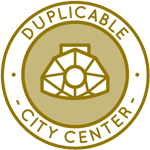 One Community is creating an ecological living paradigm through a Duplicable and Sustainable City Center that is LEED Platinum certified/Sustainable, can feed 200 people at a time, provide laundry for over 300 people, is beautiful, spacious, and saves resources, money, and space:
One Community is creating an ecological living paradigm through a Duplicable and Sustainable City Center that is LEED Platinum certified/Sustainable, can feed 200 people at a time, provide laundry for over 300 people, is beautiful, spacious, and saves resources, money, and space:
- Learn about this building and it’s function: Duplicable City Center Open Source Hub
This week, Andrew Tzu-Chien (Industrial Designer) continued working on the Dormer second-floor window for the Duplicable City Center. He researched roof and wall structure examples to enhance the existing window design and developed three structural solutions, creating an ecological living paradigm shown in a sketch for feedback. He also continued iterating on the slides, cut-sheet metrics, and 3D model based on Jae’s previous feedback. All updated files were made accessible on Dropbox for the One Community team to review. The Duplicable City Center highlights One Community’s open-source commitment to creating an ecological living paradigm. The images below illustrate aspects of this work.
Ayushman Dutta (Mechanical Engineer) continued working on reviewing pipe materials for the Duplicable City Center hub connector design. He focused on report formatting and attended the weekly meeting to review action items and plan next steps. During a meeting with Srujan and Dipak regarding the finite element analysis (FEA), Dipak presented his results and explained the process he used for the project. Based on feedback from this discussion, Ayushman corrected the model preparation, revised the hub connector FEA by incorporating team input, and prepared the model again with geometry cleaning and other adjustments needed for accurate results. Continuing with the FEA, he modeled the boundary conditions but encountered issues that required further geometry cleaning to resolve problems preventing the analysis from running correctly. Through open-source design, the Duplicable City Center demonstrates and teaches the principles of creating an ecological living paradigm. Here are several visuals related to this work.
Nikhil Bharadwaj (Mechanical Engineer) continued working on creating the spoke designs for the Duplicable City Center hub connector. He updated the dome design with beam cuts required to accommodate the new hub connector and created drawings to document the cut angles for each beam. Nikhil generated an isolated model containing only the hub connector and modified beams, which he shared with Ayushman for FEA analysis. After completing work on row 2, he began preparations for the design and assembly instructions for row 3. One Community’s Duplicable City Center is an example of creating an ecological living paradigm. Here are a few pictures that showcase this work.
Nupur Shah (Mechanical Engineer) continued work on Row 2 of the Duplicable City Center hub connector. She incorporated the latest feedback into the Row 2 design, updating the part and its documentation to reflect the requested changes. The project spreadsheet was completed and reorganized for better structure, making it easier to navigate and reference specific components. Nupur also ensured that all part names, dimensions, and annotations were accurately aligned with the revised model. With Row 2 finalized, she began initial work on Row 3, which included reviewing design requirements, setting up new files, and preparing a framework for the next phase of assembly and documentation. One Community’s Duplicable City Center serves as an open-source example of creating an ecological living paradigm. Here are a few pictures that showcase this work.
Sandesh Kumawat (Mechanical Engineer) continued working on the City Center Natural Pool and Eco-spa Designs. He designed a new spa tub model and resized the cover plates to match it, beginning by reviewing earlier geometry from the previous designer to extract key dimensions and constraints. Using SolidWorks, he created the updated tub and adjusted plate widths, lengths, and hinge locations so the set would provide full coverage of the opening with appropriate overlap at the rim. He checked clearances in front, side, and section views to minimize gaps and heat loss. Sandesh also incorporated a cable path concept using guide pulleys and a winch, added temporary anchor points on the plates, and sketched the routing to verify travel and attachment geometry. He then reviewed details from a video shared by Jae to align the model with the intended operation and mounting approach. Additionally, he prepared a detailed project timeline outlining key milestones and deliverables. Discover creating an ecological living paradigm through One Community’s open-source Duplicable City Center. The following visuals illustrate highlights from this effort.
Srujan Pandya (Mechanical Engineer) continued helping with the Duplicable City Center FEA analysis. He refined the FEA for the updated dome model, focusing on resolving discrepancies in snow load calculations. This included verifying and correcting unit mismatches, replicating snow load models to validate Shu’s results, and identifying differences between pressure loads and force loads. Incorporating feedback from Dipak, Srujan adjusted his model to match the correct snow load conditions and ran a structural analysis using the updated input data. He also began compiling scenario-specific outputs based on the validated model results. The Duplicable City Center demonstrates how open-source design can guide people in creating an ecological living paradigm. The images below illustrate aspects of this work.
Vineela Reddy Pippera Badguna (Mechanical Engineer) continued conducting in-depth research on greywater reuse systems for the Duplicable City Center as part of efforts in creating an ecological living paradigm. She extracted a 2D drawing from the 3D SketchUp file to update the website with the latest design changes. The Google Sheet was updated to include greywater pipe flow rates in GPM and corresponding drainage fixture units, added fixture types with automatic pipe size calculations, and integrated a size calculator for determining required pipe and storage tank dimensions. Vineela also incorporated the greywater pond into the floor plans, creating an ecological living paradigm. All calculations in the Google Sheet were cross-verified and updated. Finally, she revised the first-floor pipe routing to accommodate a shower near the pond and adjusted the basement greywater routing to avoid interference with the first-floor layout. This open-source Duplicable City Center project demonstrates creating an ecological living paradigm through thoughtful design. For more specifics, view the image below.
HIGHEST GOOD FOOD PROGRESS
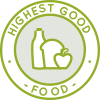 One Community is creating an ecological living paradigm through Highest Good food that is more diverse, more nutritious, locally grown and sustainable, and part of our open source botanical garden model to support and share bio-diversity:
One Community is creating an ecological living paradigm through Highest Good food that is more diverse, more nutritious, locally grown and sustainable, and part of our open source botanical garden model to support and share bio-diversity:
- Learn about the structures: Hoop House Hub | Aquapini & Walipini Open Source Hub
- See what we’ll be growing: Gardens & Hoop Houses | Large-scale Structures | Food Forest | TA
This week, the core team continued their review of the Master Tools, Equipment, and Materials/Supplies list. They completed the review of the document, correcting all remaining acronyms. The team finalized acronyms for specific projects as follows: Goat (GT), Chicken (CHICK), Rabbit (RAB), Apiary (APY), Aquapini (AQ), Walipini (WA), Botanical Garden (BG), Large Garden (LG), Food Forest (FF), Hoop House (HH), Soil Amendment (SA), Earthbag Village (EBV), Energy (ENRG), Orchard (ORCH), and Tropical Atrium (TA). The Highest Good Food initiative is a key component of One Community’s open source plans, focused on creating an ecological living paradigm, and exemplifies the organization’s commitment through innovative design and implementation. Below are some images showcasing this work.
Chelsea Mariah Stellmach (Project Manager) continued her work on the Transition Food Self-sufficiency Plan menus and customization spreadsheets. She consulted with Tyson to improve the master recipe tool and its associated tutorial and graphics, enhancing usability for new users. Chelsea provided feedback to Shireen to update the graphics based on Tyson’s changes to the tool’s functionality. She also discussed options for sharing and presenting the spreadsheet on the site, including whether users should be able to view it first or if it should default to “make a copy.” As an essential aspect of One Community’s open source goals, the Highest Good Food initiative supports creating an ecological living paradigm as a foundation for sustainable living. Below are some images showcasing this work.
Dirgh Patel (Volunteer Mechanical Engineer) continued assisting with the Climate Battery design evolutions. He summarized the differences between three greenhouse ventilation systems, comparing them based on criteria such as air direction, greenhouse length, cost, and other factors. This effort advances the cause of One Community’s mission of creating an ecological living paradigm. Dirgh added an explanation of heat gain in the greenhouse due to heat radiation, highlighting the importance of daily solar radiation, transmissivity, roof angle, and related values. He formatted the final report by editing the index and titles based on given changes, uploaded photos to Dropbox, and linked them to the report. Additionally, he explained total heat gain and compared it with central air conditioning, describing how this value changes with heat loads and across different months. He also reviewed material on how greenhouse ventilation controls temperature, humidity, and airflow—with different rates for each season—noting that airflow depends on greenhouse size and proper fan selection. Dirgh pointed out that natural ventilation is low-cost but less consistent than mechanical systems and may require insect screens. One Community’s open source mission is powerfully reflected in the Highest Good Food initiative, which is focused on creating an ecological living paradigm for global benefit. The following visuals illustrate highlights from this effort.
Faeq Abu Alya (Architectural Engineer) continued his work on the Earthbag Village. He redesigned the house in the Southeast region, updating materials, adding new elements, and improving visualizations, as well as creating a walkthrough video for both the Southwest and Southeast regions. Faeq also updated the house design in the Southwest region by adjusting materials, incorporating new features, and enhancing visualizations to align with current design specifications. One Community’s open source launch of creating an ecological living paradigm begins with Earthbag Village, the first of seven planned villages providing housing and powerfully reflected in the Highest Good Food initiative. Below are some pictures related to this work.
Jay Nair (BIM Designer) continued working on Aquapini and Walipini Planting and Harvesting lighting and HVAC design. He focused on lighting energy calculations for Greenhouse Walipini 1, addressing requirements for its individual zones. Jay reviewed the lighting specifications, updated the data for each zone, and adjusted calculations to reflect specific fixture details and seasonal variations relevant to the greenhouse’s operational needs. The Highest Good Food initiative plays a leading role in One Community’s open source platform, promoting and supporting creating an ecological living paradigm through sustainable and participatory development. See below for pictures related to this work.
Nitin Parate (Architect) continued contributing to the Highest Good Food. He updated the Walipini section based on feedback from Jae, focusing on design revisions, correcting details, and improving clarity to align with project requirements. In parallel, he progressed on a detailed axonometric view of the project site, adding a sun path diagram created in GIMP to illustrate solar exposure and shading. This visual aids design review while maintaining accuracy and presentation standards. The Highest Good Food initiative plays a leading role in One Community’s open source platform, promoting and supporting creating an ecological living paradigm through sustainable and participatory development. Below are some images showcasing this work.
Keerthi Reddy Gavinolla (Software Developer) continued working on the Highest Good Food page, specifically, details for the Soil Amendment page. She verified both the website and related documents, making necessary changes to ensure consistency in formatting, structure, and content accuracy. Keerthi also tested several pull requests on the development site and fulfilled her administrative duties for the week. Built on One Community’s open source foundation, the Highest Good Food initiative is dedicated to creating an ecological living paradigm, empowering communities through self-sustaining systems. View examples of her work in the pictures below.
Pallavi Deshmukh (Software Engineer) continued working on adding the new Zenapini 2 content to the Aquapini and Walipini Planting and Harvesting page. She completed and submitted information for four interviews and created new content for blog 646. Pallavi collaborated with teammates by reviewing their suggestions and incorporating feedback to deliver a clear and consistent final version. After incorporating feedback from Jae, she finished adding Zenapini #2 content from Silin to the website and submitted the page for review. She then began adding Walipini #2 content based on Junyi Shi’s work, including text, links, and updated images for the webpage. In alignment with One Community’s open source objectives, the Highest Good Food project integrates the concept of creating an ecological living paradigm into a larger vision of regenerative living. Her contributions are highlighted in the collage below.
Shivangi Varma (Volunteer Architectural Designer And Planner) continued contributing to the Highest Good Food and completing the Aquapini and Walipini Planting and Harvesting page and Open Source Hub page, adding content where required, formatting the page, suggesting key plans, and incorporating additional sections. She finalized edits on both pages based on feedback from Loom and coordinated with architect and graphic design volunteers to refine graphics across the three web pages. The Highest Good Food initiative plays a leading role in One Community’s open source platform by promoting sustainable and participatory development focused on creating an ecological living paradigm. Below are visuals highlighting this work.
Tyson Denherder (Volunteer Pioneer Team Member) continued contributing to the Highest Good Food by updating the Master Recipe Template and the Transition Kitchen Recipe Build-Out Tool to ensure they function as intended. He completed updates for the 3 Day Blocks Master Recipe Template and the Transition Kitchen Recipe Build-Out sheets, identifying and correcting issues with food costs and verifying that calculations and functions worked correctly. Tyson also collaborated with Chelsea to review the Recipe Build-Out Tool Report, making necessary changes to align it with the updated sheets. The Highest Good Food initiative plays a leading role in One Community’s open source platform by promoting sustainable and participatory development focused on creating an ecological living paradigm. Below are images related to this project. 
HIGHEST GOOD ENERGY PROGRESS
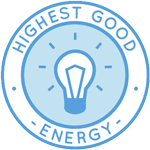 One Community is creating an ecological living paradigm through Highest Good energy that is more sustainable, resilient, supports self-sufficiency and includes solar, wind, hydro and more:
One Community is creating an ecological living paradigm through Highest Good energy that is more sustainable, resilient, supports self-sufficiency and includes solar, wind, hydro and more:
- Learn about the open source sustainable-energy foundations: Solar, Hydro, and Wind
- Explore our research into the most sustainable products and companies for saving water and energy: Insulation, Eco-laundry, Lightbulbs and Light Bulb Companies, Doors and Door Companies, Windows and Window Companies, Toilets, Faucets and Faucet Accessories, Urinals, and more.
This week, Dishita Jain (Data Analyst) continued supporting with the Highest Good Energy research and cost analysis for creating an ecological living paradigm. She worked on OC Administration and HG Energy projects, creating collages and adding summaries to WordPress for the team review. For HG Energy, Dishita completed the energy needs sheet for all phases, updated several figures based on additional research, and sent the revised versions to Jae for review. One Community’s open source mission is powerfully reflected in the Highest Good Energy initiative, which contributes to creating an ecological living paradigm as a model for global benefit. Below are images showcasing this work.
HIGHEST GOOD EDUCATION PROGRESS
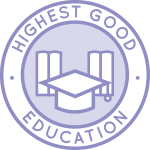 One Community is creating an ecological living paradigm through Highest Good education that is for all ages, applicable in any environment, adaptable to individual needs, far exceeds traditional education standards, and more fun for both the teachers and the students. This component of One Community is about 95% complete with only the Open Source School Licensing and Ultimate Classroom construction and assembly details remaining to be finished. With over 8 years of work invested in the process, the sections below are all complete until we move onto the property and continue the development and open sourcing process with teachers and students – a development process that is built directly into the structure of the education program and everything else we’re creating too:
One Community is creating an ecological living paradigm through Highest Good education that is for all ages, applicable in any environment, adaptable to individual needs, far exceeds traditional education standards, and more fun for both the teachers and the students. This component of One Community is about 95% complete with only the Open Source School Licensing and Ultimate Classroom construction and assembly details remaining to be finished. With over 8 years of work invested in the process, the sections below are all complete until we move onto the property and continue the development and open sourcing process with teachers and students – a development process that is built directly into the structure of the education program and everything else we’re creating too:
- Program Overview: Education Open Source Hub
- How the components work together in designing human orchestrated eco-abundance: How to use the Education for Life Program
- Lesson Plans for Life – Lesson Plans How-to
- Foundations of Outstanding Leaders, Teachers, and Communicators
- Curriculum for Life
- Teaching Strategies for Life
- Learning Tools and Toys for Life
- Evaluation and Evolution
This week, Anuneet Kaur (Administrator) continued contributing to the progress of the Highest Good Education software platform by creating Figma design elements, and enhancing the overall visual layout. She refined and updated shared navigation elements based on Harshitha’s feedback, improving consistency, user flow, and responsive design. Anuneet researched sustainable paints, stains, varnishes, and sealers, compiling relevant statistics and scholarly resources. She ensured all team members were included in the live blog task, began drafting content and selecting images for the Licensing and Accreditation webpage, and provided feedback on Yulin’s sustainable infographic. Additionally, she supported the training and hiring teams by reviewing work, conducting interviews, and fulfilling administrative duties, including editing summaries and collages for various teams. The One Community model of creating an ecological living paradigm, exemplified by sustainably built classrooms like these, drives sustainable change on a global scale. Her recent contributions are featured in the collage below.
Harshitha Rayapati (Program Manager) continued advancing the Highest Good Education platform by detailing deliverables, developing Figma designs, and expanding the visual layout of the student dashboard. She reviewed and provided feedback on Figma designs created by Ravi for Deliverable 1 and offered input on the Deliverable 2 action items prepared by Sphurthy. Harshitha expanded the landing pages’ software outline to include options for both student and teacher navigation bars, explained necessary changes in Deliverable 1 to Sphurthy for rework, and addressed Ravi’s questions on design requirements. She also compiled the weekly blog update, reviewed Housing’s progress, edited the blog page, created a collage, and implemented admin-requested changes. The One Community model of creating an ecological living paradigm, exemplified by sustainably built classrooms like these, drives global sustainable change. The collage below highlights her recent contributions.
Ravi Kumar Sripathi (Software Engineer) continued working on the Highest Good Education software platform by creating Figma designs and enhancing the overall visual layout. He designed the Grading – Document Review Workflow and the Student Profile module for the Teacher’s Dashboard. The grading workflow allows educators to review student-submitted assignments in .docx or .pdf format with page-by-page navigation, fields for total marks, marks awarded, collaborative and private feedback, and options to save progress on each page. The interface features a split layout: document preview on the left, and feedback fields, grading controls, and action buttons such as “Save Progress,” “Request Changes,” and “Mark as Graded” on the right. A student profile panel displays the learner’s name, photo, grade, class, and assignment name, with standardized grade options ranging from “A+: World Class” to “C: Fail.” This work supports One Community’s mission of creating an ecological living paradigm.
Additionally, Ravi developed the Student Profile feature in Figma, providing a read-only view of academic records, achievements, and interests. This includes an information panel, portfolio and showcase section, and a tabbed view covering educational progress, completed lessons, current tasks, and student interests. Usability enhancements such as clickable education atoms within education molecules, collapsible lesson details with grades, and lists of teaching strategies and learning tools were specified to support teachers, students, and staff. Access control rules ensure only relevant stakeholders can view each content type. The One Community model of creating an ecological living paradigm, exemplified by sustainably built classrooms like these, drives lasting global change. Below are images related to his work.
HIGHEST GOOD SOCIETY PROGRESS
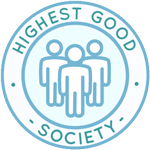 One Community is creating an ecological living paradigm through a Highest Good society approach to living that is founded on fulfilled living, the study of meeting human needs, Community, and making a difference in the world:
One Community is creating an ecological living paradigm through a Highest Good society approach to living that is founded on fulfilled living, the study of meeting human needs, Community, and making a difference in the world:
- Read the Highest Good society overview: Highest Good Society
- Learn about the model for fulfilled living and sharing: A Day in the Life
- Learn about the 4 economic models: RBE | For-profit | Non-profit | Entrepreneurship
- Learn about our open source community collaboration and management software: The Highest Good Network
This week, the core team completed over 54 hours managing volunteer work reviews, handling emails, overseeing social media accounts, supporting web development, identifying new bugs, integrating bug fixes for the Highest Good Network software, and interviewing and onboarding new volunteer team members. They also produced and incorporated the video above, illustrating how creating an ecological living paradigm forms the foundation of One Community’s broader mission. The image below highlights some of this work.
Govind Sajithkumar (Project Manager) continued focusing on analytics and content management for Meta’s Facebook and Instagram channels. He scheduled weekly posts and logged relevant details such as post type, tags, and media in the open-source tracking spreadsheet. Govind also updated the Meta Analytics and Reporting Spreadsheet weekly, refreshing audience demographics for both platforms. As part of PR Review Team Management, he provided feedback on team documents, updated a WordPress site with the team’s weekly summary and collage, and maintained the PR Review Team Table and HGN PR Spreadsheet. He also submitted his admin feedback table, supporting One Community’s mission of creating an ecological living paradigm. The images below highlight key aspects of this work.
Jaiwanth Reddy Adavalli (Project Manager) continued developing the Job Applicants page along with key components of the Highest Good Network Phase 2 and Phase 4 dashboards, including the PR Team analytics section. He worked on the Listing and Bidding Dashboard by designing graphs and documenting related action items. Jaiwanth also identified CSS code errors causing issues in various HGN software components and created action items to address them. As part of the pull request review team, he reviewed submissions from assigned volunteers. This project plays a vital role in One Community’s commitment to creating an ecological living paradigm. The images below highlight his contributions from this week.
Rajrajeshwari Gangadhar Sangolli (Data Analyst) began working on the Google Ads management and strategy evolution. She worked on her administration training, completing all required steps and submitting her work for review by Tuesday. She prepared weekly summaries for the core team and team alpha volunteers as part of the assignment. She also created collages, ensuring they met the required size and dimension specifications. Rajrajeshwari addressed remarks and reviews from the team, making the necessary corrections to her work. She attended a meeting with Jae and began work related to Google Ads by reviewing the admin document and reading the Google Ads document. After completing the reading, she watched tutorials on Google Ads to prepare for her tasks in this area for the company. This project plays a vital role in One Community’s commitment to creating an ecological living paradigm. The images below highlight key aspects of this work.
ADMINISTRATION TEAM
The Administration Team summary, covering their work administrating and managing most of One Community’s ongoing process for creating an ecological living paradigm was managed by Bhakti Tigdi (Project Manager) and includes Harsha Ramanathan (Administrator), Neeharika Kamireddy (Data Analyst), Olawunmi “Ola” Ijisesan (Administrative and Management Support), Olimpia Borgohain (Data Analyst and Team Administrator), Rachna Malav (Data Analyst), Rajeshwari Bhirud (Administrator), Rishi Sundara (Quality Control Engineer and Team Administrator), Rishitha Adepu (Administrator), and Samhitha Are (Administrator). The Highest Good Network software is how we’ll be managing and objectively measuring our process for creating an ecological living paradigm through our social architecture, construction, production, and maintenance processes.
This week, the Administration team continued supporting operations across task management, documentation, recruiting, software review, and content creation. Harsha reviewed reference videos, generated AI music using the Suno platform, organized outputs, and incorporated feedback. This work reflects the priorities of One Community in creating an ecological living paradigm. Neeharika reviewed software team documents and PR dashboards, followed up with task owners, tested pull requests, completed admin duties, reviewed new admin training, and conducted five interviews. Ola organized administrative files, reviewed progress tracking spreadsheets, prepared workspaces, corrected PR review tables, and uploaded weekly tasks. Olimpia reviewed four new volunteers’ work, managed LinkedIn posts with hashtags, completed weekly admin tasks, set up blogs for two teams, and reviewed submissions. Rachna worked on SEO, reviewed website pages, responded to emails, and scheduled candidate interviews. This work supports One Community’s mission of creating an ecological living paradigm.
Rajeshwari reviewed summaries, resolved missing information, updated Step 2 documents, edited the private WordPress blog with weekly updates and collages, completed the HGN questionnaire, updated admin feedback tracking, finalized and uploaded a PDF, and explored testing environments for Phase 2. This project is a part of One Community’s ongoing creation of an ecological living paradigm. Rishi tested completed PRs in the HGN Phase 1 document, followed up on pending PRs, communicated with contributors about Node version upgrades, and merged individual blogs into the main blog while performing SEO work. Rishitha updated the weekly blog, corrected bio announcements, guided new members through training, scheduled and conducted six interviews, arranged additional interviews, reviewed social media training materials, obtained Bluesky access, and requested access for Twitter and Threads. Samhitha reviewed training steps for four volunteers, updated a blog, adjusted the team picture, performed Phase 3 Level 1 software testing, formatted project files, created action items for completed PRs, tracked work-in-progress PRs, reviewed all active PRs, and coordinated with new developers replacing those who left. This work contributes to One Community’s mission of creating an ecological living paradigm. See below for images highlighting their efforts.
GRAPHIC DESIGN TEAM
The Graphic Design Team’s summary includes work from Qinyi Liu (Graphic Designer) and Yulin Li (Graphic Designer), who focused this week on creating graphic designs that support creating an ecological living paradigm.
Qinyi updated previously identified posters and created new designs, generating several new character concepts using MidJourney and ChatGPT. She refined these in Photoshop and integrated them into scenes for updated posters related to creating an ecological living paradigm. Yulin contributed by revising infographics and social media images for clarity and sustainability, creating graphics that highlight aspects of creating an ecological living paradigm. She also managed Dropbox version control and participated in weekly team discussions. See the Highest Good Society pages for more on how this contributes to creating an ecological living paradigm. The collage below showcases examples of their work.
HIGHEST GOOD NETWORK PROGRESS
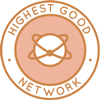 One Community is creating an ecological living paradigm through open source Highest Good Network® software that is a web-based application for collaboration, time tracking, and objective data collection. The purpose of the Highest Good Network is to provide software for internal operations and external cooperation. It is being designed for global use in support of the different countries and communities replicating the One Community sustainable village models and related components.
One Community is creating an ecological living paradigm through open source Highest Good Network® software that is a web-based application for collaboration, time tracking, and objective data collection. The purpose of the Highest Good Network is to provide software for internal operations and external cooperation. It is being designed for global use in support of the different countries and communities replicating the One Community sustainable village models and related components.
- Learn about our open source community collaboration and management software: The Highest Good Network
This week, the core team continued working on the Highest Good Network software pull requests and resolved several key issues. These included fixes for Team Member Task Section Freeze/Shakes on small screens (#2888), Total Org Summary – Share as PDF Feature (#3361), leaderboard fixes (#3513), Volunteer Status comparison percentage (#3545), setting up routes and folder structure for the HGN Help Dashboard (#3360), and Total Org Summary – Work Distribution Bar Chart fixes (#3512). This effort advances One Community’s focus on creating an ecological living paradigm.
Several items remain unresolved, including the fix for other’s dashboard view (#3413); issues with assigned badges in categories such as “10,000 hours,” “1,000 hours,” “600 hours,” “200 hours,” and “100 hours”; optimization of loading time for WBS (#3186 + #11286); Hours Completed Bar Chart (#3503); and grouped_bar_graph_named_paid_labor_cost_frontend (#3420). Additional tasks included assigning work to volunteers, communicating via Slack about merged pull request issues, reporting new bugs related to dashboard views and loading speeds, and setting up an account to test badges like “5x-2x Minimum Hours,” “NEW MAX,” and “Most Hours in a Week.” See the Highest Good Society and Highest Good Network pages for more on how this work supports One Community’s commitment to creating an ecological living paradigm. The collage below highlights some of these efforts.
ALPHA SOFTWARE DEVELOPMENT TEAM
This week, the Alpha Software Team, working on the Highest Good Network software, was managed by Lin Khant Htel (Frontend Software Developer), Carlos Martinez (Full-Stack Software Developer), and Nikita Kolla (Full Stack Developer). This software serves as an internal management and communication platform designed to support creating an ecological living paradigm. Lin reviewed PR #1530, tested the changes locally with all eight test cases passing, consulted with team members, reviewed weekly summaries, photos, and videos from Alpha team members, and managed Alpha team operations.
Carlos implemented a backend fix for blue square descriptions by adding author names to infringement records. He also tested the automatic assignment of blue squares using tokens for authorization through Postman and updated the frontend to correctly format dates and names in add, update, and view modals. Nikita worked on the backend for the Project Status donut chart, experimented with Bootstrap layouts, adjusted dark mode colors and classes, and resolved CSS breakpoint issues for mobile layouts. For more on how this work supports creating an ecological living paradigm, see the Highest Good Society and Highest Good Network pages. See some of the team’s work in the collage below.
BINARY BRIGADE SOFTWARE DEVELOPMENT TEAM
The Binary Brigade Team’s summary, presenting their work on the Highest Good Network software, was managed by Nikhil Routh (Software Engineer) and includes Amalesh Arivanan (Software Engineer), Ramsundar Konety Govindarajan (Software Engineer), Harika Majji (Software Engineer), Harsha Rudhraraju (Software Engineer), Rohit Mamidi (Software Engineer), Manvi Kishore (Software Engineer), and Taariq Mansurie (Full-Stack Developer). The Highest Good Network software is our tool for managing and objectively measuring progress, ensuring that all contributions are effectively tracked, aligned with our mission, and creating an ecological living paradigm.
This week, Harika pushed code changes to a new branch after testing and began updating the styling approach by converting .css files to .module.css for the Registration Page, creating tasks to track this conversion for the Registration Page, Wishlist, BiddingHomePage, and ImageCarousel to ensure scoped styles did not affect functionality. Rohit started badge testing by planning a cron job to simulate accelerated time, analyzing the codebase, and developing scripts to trigger badge conditions. This work supports One Community’s mission of creating an ecological living paradigm. Manvi resolved a merge conflict between dev and main backend branches, then worked on badge testing with a strategy to simulate verification scenarios. Taariq fixed filter color bugs, restarted processes for Node version compatibility, implemented global storage for filter selections, and addressed weekly summary report bugs. Harshavarma created new tasks for non-functional pull requests, followed up with developers, and reviewed multiple frontend and backend PRs, identifying UI and dark mode issues, retesting after fixes, and tracking progress. This work contributes to One Community’s vision of creating an ecological living paradigm.
Ram resolved issues assigned by Jae, including fixing UI borders, confirming expected WBS task behaviors, and restoring Redux state mapping to fix application crashes. Nikhil migrated legacy CSS files to CSS Modules, updated imports and className attributes, addressed upgrade compatibility issues, and fixed review feedback in key PRs. Amalesh fixed contributor report display issues, improved permissions management tracking with auto-refresh and accurate change naming, and completed onboarding tasks with detailed documentation and time tracking. See the Highest Good Society and Highest Good Network pages for more about how this relates to creating an ecological living paradigm. The collage below shows images of their work.
BLUE STEEL SOFTWARE DEVELOPMENT TEAM
The Blue Steel Team’s summary, presenting their work on the Highest Good Network software, was managed by Sheetal Mangate (Software Engineer) and includes Humemah Khalid (Software Engineer/Backend Developer) and Linh Huynh (Software Engineer). The Highest Good Network software is our tool for managing and objectively measuring progress, ensuring that all contributions are effectively tracked, aligned with our mission, and creating an ecological living paradigm.
This week, Linh focused on testing and debugging the Weekly Company Summary Email edit functionality to resolve issues where updates were not immediately visible in the UI. She reproduced the problem in both frontend and backend environments, verified relevant components and API calls, and found that a missing or mismatched backend route caused a 404 error. Linh reviewed backend route configurations, controller logic, and frontend implementations to determine whether updating the route or restructuring functions was needed, testing the development branch and prior pull requests to confirm the behavior. Meanwhile, Humemah enhanced the database and frontend to better store reasons for blue square infringements by adding a new field for predetermined reasons, applied only to new infringement records, improving queryability. This effort advances One Community’s focus on creating an ecological living paradigm. Sheetal addressed a “Bad Request” error in Reddit OAuth caused by duplicate requests from the useEffect hook firing twice. She restructured the authentication flow by creating a separate callback component to ensure a single request is sent, allowing the backend to correctly retrieve the Reddit access token. Additionally, Sheetal modified the flow to support storing access and refresh tokens securely in the database, evaluating storage options and exploring hashing methods for these sensitive tokens. She also implemented a redirect from the callback URL to the frontend announcement page after authentication completion. See the Highest Good Society and Highest Good Network pages for more about how this relates to creating an ecological living paradigm, and the collage below for images of their work.
CODE CRAFTERS SOFTWARE DEVELOPMENT TEAM
The Code Crafters Team, covering their work on the Highest Good Network software, was managed by Sai Shekhar Reddy Moola (Software Engineer) and includes Ajay Naidu (Software Engineer), Chaitanya Swaroop Kumar Allu (Software Engineer), Humera Naaz (MERN developer), Juhitha Reddy Penumalli (Software Engineer), Rohith Mallipudi (Software Engineer), Sphurthy Satish (Software Engineer). The Highest Good Network software is how we’ll manage and objectively measure our process for establishing abundant community systems through our social architecture, construction, production, and maintenance processes, and support widespread and lasting eco-lifestyle access. This effort exemplifies One Community’s open-source commitment to creating an ecological living paradigm.
This week, Juhitha fixed a dark mode issue in the Building Management dashboard pages by updating CSS classes and color schemes to restore proper styling without affecting the main dashboard’s light mode. Sphurthy enhanced student and educator dashboards by improving task tracking, enforcing hours logging before task completion, and adding a dynamic report with filtering and late submission tagging for educators. This work contributes to One Community’s vision of creating an ecological living paradigm. Chaitanya improved the Access Management system by automating contributor role assignments via Sentry and enhancing Dropbox folder tracking with better error handling and documentation. Ajay resolved color inconsistencies in a pie chart, addressed merge conflicts, fixed bugs related to Node.js version 20, and updated chart logic to prevent errors when no hours were logged. Rohith coordinated task delegation, tested pull requests for correct visualizations, and communicated with contributors. Humera addressed Node version conflicts and backend accessibility issues in development environments. See the Highest Good Society and Highest Good Network pages for more on how this relates to creating an ecological living paradigm. View some of the team’s work in the collage below.
DEV DYNASTY SOFTWARE DEVELOPMENT TEAM
The Dev Dynasty Team’s summary, covering their work on the Highest Good Network software, was managed by Zhifan Jia (Software Engineer) and includes Adithya Cherukuri (Volunteer Software Engineer), Deekshith Kumar Singirikonda (Developer), Dharmik Patel (Software Engineer), Manvitha Yeeli (Software Engineer), Mohan Satya Ram Sara (Software Engineer), Nahiyan Ahmed (Full Stack Software Developer), Neeraj Kondaveeti (Software Engineer), Saicharan Reddy Kotha (Software Engineer), Sankar Sai (Software Engineer), Shraddha Shahari (Software Engineer), Vamsi Krishna Rolla (Software Engineer), Vamsidhar Panithi (Software Engineer), and Varsha Karanam (Software Engineer). The Highest Good Network software is how we’ll manage and objectively measure our process for creating an ecological living paradigm through our social architecture, construction, production, and maintenance processes to support widespread and lasting eco-lifestyle access. This progress helps drive One Community’s creating an ecological living paradigm goals forward.
This week, Nahiyan reviewed PR 3797, which resolved a dark mode issue on the Reports page by applying inline styling to the “Start Date” and “End Date” labels, confirming the fix but noting that the background color remained white in dark mode and suggesting additional changes. Shraddha worked on frontend PR cleanup by addressing test failures in PRs 2769, 3461, 2210, 2266, and 3492, and submitted a PR to fix .env credential loading issues causing MongoDB connection errors. This work furthers One Community’s dedication to creating an ecological living paradigm. Vamsi Krishna cloned the backend repository, defined the MongoDB schema, and implemented /rentals/cost-over-time and /tools/cost-breakdown endpoints using Mongoose aggregation for cost calculations, testing them in Postman. Dharmik developed the PR Review Team Analytics Dashboard with four Reactstrap-based routes and components, updated navigation, and addressed Node.js version mismatches, Rollup errors, Redux bugs, and test failures, replacing full dashboard functionality with placeholders. Manvitha fixed the bio announcement toggle inconsistency, updated PR 3510 with review feedback, implemented tag removal and dark mode support, and integrated teamCode and isMentor retrieval for the PR review dashboard API. Saicharan tested PRs 1600, 3552, and 3660 for Phase-2 Summary Dashboard features, created high-priority action items for new graph components, and documented progress with screenshots while coordinating with developers. Varsha reviewed PRs, updated task documentation, created new tasks, addressed communication gaps, and contributed to Phase 2 development, dummy data setup, and UI checks. This work furthers One Community’s dedication to creating an ecological living paradigm.
Prasanth reviewed over 50 pages of Phase 2 documentation, tested frontend and backend PRs, identified issues, created new tasks, coordinated fixes via Slack, and collaborated with Sai Charan and Varsha to audit implementation, validate features, and recommend UI/UX improvements. This task is part of One Community’s mission to create an ecological living paradigm. Deekshith developed a frontend registration component with input validation, managed state with useState, added toast notifications, and implemented a backend /lbdashboard/register endpoint using Express and MongoDB, resolving ESLint and syntax errors before submitting a PR. Vamsidhar resolved merge conflicts and test failures for PRs 1404, 1540, and 3758, fixed dependency mismatches and node version issues, and tested admin features in HighestGoodNetworkApp locally. This task is part of One Community’s mission to create an ecological living paradigm. Adithya created a horizontal bar chart for job analytics showing average pledged months by role, structured filters with react-select and react-datepicker, connected it to the API, and refined layout and logic. This contribution aids One Community’s pursuit of creating an ecological living paradigm. Neeraj enhanced job analytics charts by resolving data display issues, inserting MongoDB test data, fixing import errors, and implementing updated tooltips with detailed information. Sankar set up the backend, verified merged PRs for Listing and Messaging features, created tasks for pending work, and confirmed Create Listing endpoint functionality while encountering unresolved frontend react-scripts errors. Zhifan resolved merge conflicts in PR 1337, advanced backend analytics development by implementing endpoints, testing with Postman, configuring a cron job for data aggregation, and addressing duplicate summary generation and date-based query issues. See the Highest Good Society and Highest Good Network pages for more on how this relates to creating an ecological living paradigm. View some of the team’s work in the collage below.
EXPRESSERS SOFTWARE DEVELOPMENT TEAM
The Expressers Team’s summary, which covers their work on the Highest Good Network, was managed by Rahul Trivedi (Software Engineer) and includes Meenashi Jeyanthinatha (Full Stack Developer), Reina Takahara (Software Developer), and Tanmay Arora (Software Engineer). The Highest Good Network software helps us manage and objectively measure our progress toward creating an ecological living paradigm through innovative software development, testing, and collaboration.
This week, Meenashi added EventFeedback to the collection with fields for name, email, and rating. She updated both pull requests with test instructions and a video showing the changes. She pulled the latest development changes into the create bidding PR to address the older Node version and resolved merge conflicts caused by the Node version update. This activity supports One Community’s purpose of creating an ecological living paradigm. The build failed due to a Husky pre-commit hook error; after resolving conflicts, she used the -no-verify flag to commit and push, but the build continued to fail. She tested the updated code for ESLint errors, fixed them, and the build test then completed successfully. For the questionnaire PR, she pulled the latest front-end and back-end changes from development, resolved merge conflicts, and noted that pushing changes continued to require the -no-verify flag for pushing, which was not tested in the most recent attempt. Rahul made styling changes to adjust the layout by modifying the CSS files and worked on improving the logic of the Navbar. He updated the styling and scrolling behavior, adjusted the height and overall layout, and tested the Navbar on different screen sizes to ensure consistency. Functionality for the Navbar was implemented, along with additional styling changes and minor updates. In his role as Manager, Rahul reviewed all group members’ summaries, videos, and images, and checked their submitted work for completeness. This effort is linked to One Community’s aim of creating an ecological living paradigm.
Reina worked on the HGN Software Development project, addressing connection and authentication errors in the frontend after switching to Node v20. She fixed a network issue by updating the connection from a local port to the correct cloud endpoint and prepared a new pull request listing in anticipation of creating a branch to support linking the survey form to the application for data collection. This work plays a role in One Community’s strategy for creating an ecological living paradigm. Tanmay continued work on the “Special Action Item for the Referral Link Requirement (WIP Tanmay)” feature in the HighestGoodNetworkApp, enabling creation and customization of unique referral links for each job ad with optional source identifiers for tracking. He implemented functionality to capture and log the source of each click by reading the identifier from the URL and storing it in the backend for analysis. He worked on the branch tanmay-feature-restore-refresh-notice-popup, attempted to push local changes but encountered permission errors, reviewed old Slack messages, configured SSH access, and contacted Jae for access restoration, but the push remained unsuccessful. See the Highest Good Society and Highest Good Network pages for more on how this contributed to creating an ecological living paradigm. See the collage below to view the team’s work.
LUCKY STAR SOFTWARE DEVELOPMENT TEAM
The Lucky Star Team’s summary, which covers their work on the Highest Good Network, was managed by Barnaboss Puli (Volunteer Software Engineer) and includes contributions from Dipti Yadav (Software Engineer), Durga Venkata Praveen Boppana (Software Engineer), Ganesh Karnati (Software Engineer), Kedarnath Ravi Shankar Gubbi (Software Engineer), Manoj Gembali (Software Engineer), Pranav Govindaswamy (Software Developer), Shashank Madan (Software Engineer), Veda Bellam (Software Engineer), and Venkataramanan Venkateswaran (Software Engineer). Their work continued to support our goal of creating an ecological living paradigm through collaborative and cross-functional software development.
This week, Barnaboss contributed to the HGN Software Development project by creating the /bmdashboard/lessons/add route and page, scaffolding the layout with a textarea, tag input, and permission dropdown. He built a React Hook Form-based form featuring project name auto-tagging logic, implemented multi-tag input with “enter” key functionality, added a role-based visibility dropdown, and included user experience (UX) validation and tooltips. This project supports One Community’s efforts toward creating an ecological living paradigm. He also progressed on the Twitter/X autoposter and investigated a deadline tracking bug. Dipti worked on implementing role change confirmation modals, analyzing role permission handling, and reverting code changes that caused issues while continuing to identify a solution. She also addressed a separate problem she had previously identified. Durga fixed a dark mode issue on the report page, addressed suggestions for start and end date fields, applied XSS protection, added a test case for the review button, generated a pull request, began work on the header visibility issue at specific page sizes, and added x-axis and y-axis labels to bar graphs while reviewing their dark mode display. Ganesh completed changes for the loss tracking line graph, resolved merge conflicts, tested, and pushed code. He also adjusted the bar graph for expensive or loss-making open issues to pass tests and submitted a pull request. Kedarnath converted all .css files to .module.css, updated imports, and replaced static class names with scoped CSS module references to prevent unintended style overrides. This work plays a role in One Community’s strategy for creating an ecological living paradigm.
Manoj removed page view components and routes for the Cost Prediction and Tool Availability charts, integrated filters into card views, resolved merge conflicts, fixed test cases, addressed review feedback, and resolved a chart overflow issue. Pranav improved label responsiveness for a donut chart, updated the “Applicants Grouped by Age” chart with title case, axis labels, exact data labels, and responsive layout adjustments. He reproduced and fixed reported issues related to title casing, missing labels, and centered loading messages. This work is in service of One Community’s commitment to creating an ecological living paradigm. Shashank fixed code to pass tests, merged changes, submitted a pull request for refreshing multiple pages, and created grouped-bar charts for issues by type on both the frontend and backend with dark mode support, CSS styling, secure API access, and aggregation logic. Veda created a donut chart showing candidate breakdown by experience and education, fixed build and import issues, added dummy data, ensured UI rendering, implemented stable colors, date range and role filters, responsive design, updated donut center text, added empty and error states, and refined formatting, layout alignment, and input sizing. Venkataramanan raised multiple frontend pull requests addressing UI alignment, toggle behavior, and data display fixes, along with a backend pull request for resolving a merge conflict. He also reviewed another pull request to improve his backend conflict resolution process. See the Highest Good Society and Highest Good Network pages to learn more about how this work supports creating an ecological living paradigm. See the collage below to view the team’s work.
MOONFALL SOFTWARE DEVELOPMENT TEAM
This week’s summary was managed by Rishitha Adepu (Software Administrator) and includes Shashank Kumar (Software Engineer), Aayush Jayant Shetty (Software Engineer), Alisha Walunj (Software Engineer), Bangaru Babu Kota (Software Engineer), Bhavpreet Singh (Software Engineer), Gurusai Chittoji (Software Engineer), Ramakrishna Aruva (Software Engineer), Sai Krishna (Software Engineer), and Uha Kruthi (Software Engineer).
Aayush reviewed the functionality of a pull request changing CSS files to module.css in the /hgnteam directory, updated the PR Admin Dashboard by changing CSS files to module.css in the /memberlist directory, created a pull request, and confirmed and tested action items for the Highest Good Network Questionnaire and Analytics Dashboard. This task aligns with One Community’s priorities in creating an ecological living paradigm. Alisha worked on a dropdown filter to filter by village, integrating the frontend with the backend API to fetch village names and display a detail page, with image resizing remaining. She also started work on the bidding page overview, addressing changes to fetch a productId for navigation and working on dynamically fetching user details. Bhavpreet created and fixed the job portal page, resolving CSS display issues, adding animations and responsiveness, and continued work on the job analytics page. Gurusai reviewed updates from ongoing tasks, progress shared by team members, and pull request reviews, all contributing toward creating an ecological living paradigm.
Ramakrishna, after encountering a blocker with a backend task, focused on resolving conflicts in a pull request for adding badges to a user by creating a new branch from the latest development code and manually adding the changes. He then updated the assignBadge.jsx component and the associated table. Sai worked on fixing the reset password functionality by removing the “Reset / Change Password (Others)” permission and using the existing “Update Password (Others)” permission. He updated the permission check and button rendering logic, added a condition to prevent users from resetting their own passwords, removed a condition blocking volunteer users, and started analysis for a donut chart showing planned cost breakdown. Shashank raised four pull requests for work on the payment feature, the review component, and a delay issue. He also resolved merge conflicts following the Node 20 upgrade, which included adjustments to the Vite build process. This work is in service of One Community’s commitment to creating an ecological living paradigm.
Uha completed testing for multiple features, including PRs #1280, #3293, and #1402 for Location-Based Search, PR #1341 for the Booking System, and PR #3322 for Availability Management, all of which were merged. For the Bidding Platform, the backend (PR #1462) is pending testing while the frontend is working. A developer worked on a Phase 2 Summary Dashboard line chart for total rentals cost, noting that the chart appeared squished and required adjustments to its container or height settings. This project supports One Community’s efforts toward creating an ecological living paradigm. They also reviewed all pull requests in a related project document and tracked action items for the Highest Good Network Software Team Questionnaire and the PR Team Admin Dashboard. See below for some of the team’s work.
REACTONAUTS SOFTWARE DEVELOPMENT TEAM
The Reactonauts Team’s summary, covering their work on the Highest Good Network was managed by Olimpia Borgohain (Data Analyst and Team Admin) and Akshay Jayaram (Software Engineer). The team includes Fatima Villena (Software Engineer), Ghazi Rahman Shaik (Software Engineer Intern), Guirong Wu (Software Engineer), Guna Pranith Reddy Cheelam (Software Developer), Jaydeep Mulani (Software Developer), Kristin Dingchuan Hu (Software Engineer), Peterson Rodrigues dos Santos (Full Stack Developer), Rishwa Patel (Software Developer), Siva Putti (Software Engineer), Sreeja Nandyala (Software Engineer), Sri Satya Venkatasai Siri Sudheeksha Vavila (Software Engineer) and Suparshwa Patil (Software Engineer). The Highest Good Network software helps manage and objectively measure progress by focusing on creating an ecological living paradigm. It supports social architecture, construction, production, and maintenance processes to build sustainable and thriving ecosystems. This solution is portable, scalable, and ideal for off-grid or sustainable living communities.
This week, Akshay opened PR3852 to address an issue with rendering the PeopleReport page and resolved a CSS problem caused by a previous PR merge. He also worked on tasks related to creating an ecological living paradigm and on fixing radio button state issues on the reports page by investigating global CSS overrides and implementing scoped CSS fixes. He coordinated Reactonauts team activities by tracking daily pull requests, assisting with Git errors, and submitting the weekly team review. Fatima worked on resolving bugs related to the Node v20 update in her frontend PR for the PR dashboard, created a pie chart titled “Distribution of Labor Hours” for the Phase 2 Summary Dashboard, and completed related styling updates. Ghazi optimized task assignment by refactoring TagsSearch and AddTaskModal components to use a preloaded allMembers dataset, implemented focused input suggestions excluding already-assigned users, resolved data inconsistencies, fixed a failing test blocking merges, added debugging logs, and resolved merge conflicts related to the default password pull request.
Guirong contributed to creating an ecological living paradigm by reviewing PR requests after time away, providing feedback on Marcus’s announcement tab wireframe PR regarding social media dropdown inputs, and examining Sankar Galla’s CSS migration PR for the messaging dashboard, verifying correct message page redirection. Guna Pranith worked on the listings home page frontend, addressing console errors from image GET requests during page load and correcting duplicate tab headings so that “Listings Page” and “Biddings Page” display correctly. Jaydeep progressed on the BlueSquare Manual Email Trigger Buttons feature by finalizing permission handling, ensuring only specific users can grant resend permissions, implementing backend changes for initial permissions, updating and fixing unit tests, syncing branches with development, testing integration, and resolving issues found during testing. Kristin worked on the Node.js upgrade by resolving conflicts in PR3729 for the Promotion Eligibility Table, rebasing with the latest development branch, creating a new branch for a similar Promotion Table implementation in PR3851, and investigating blank card display issues in merged frontend PR3365 by reviewing backend APIs. This task aligns with One Community’s priorities in creating an ecological living paradigm.
Peterson added a “No users found” message in the autocomplete input on the Permissions Management page to inform users when no matching username exists. Rishwa implemented the backend endpoint GET /api/promotion-details/:reviewerId to retrieve reviewer information and weekly PR statistics, defined MongoDB queries to aggregate counts per week, added error handling for missing reviewer IDs, wrote unit tests to cover expected responses, updated the API documentation, and integrated performance trend analysis by adding a consistency flag. This work reflects the priorities of One Community in creating an ecological living paradigm. Siva fixed the misalignment of End Date and Status on the Profile page, resolved an issue with Start Date not saving in the “Volunteering Time” tab, and made requested changes to PR#3658 to improve the “Create New Team” flow under Other Links > Team Management. Sreeja worked on the cleanup of the Application Page and Function document and tracked progress on multiple action items for PRs 1188, 1195, and 1285. She followed up via Slack on PR 21 for the frontend of the analytics page by Sai Girish. Siri Sudheeksha created PR3872 to convert the /totalorgsummary page to CSS Modules, fixed a JSX ternary bug, stabilized the PDF export, and verified styling and layout consistency. Suparshwa addressed a bug in modifying the bio announcement so that updated values display immediately after a refresh by adjusting data refresh and display logic. See the Highest Good Society and Highest Good Network pages to learn more about how this work supports creating an ecological living paradigm. See below for the work done on creating an ecological living paradigm.
SKYE SOFTWARE DEVELOPMENT TEAM
Skye Team’s summary, covering their work on the Highest Good Network was managed by Olimpia Borgohain (Data Analyst and Team Admin) and Anthony Weathers (Software Engineer). The team includes Gopikalakshmi Asok Kumar (Software Developer), Julia Ha (Software Engineer), Marcus Yi (Software Engineer) and Snehal Dilip Patare (Software Engineer). The Highest Good Network software helps manage and objectively measure progress by focusing on creating an ecological living paradigm. It supports social architecture, construction, production, and maintenance processes to build sustainable and thriving ecosystems. This solution is portable, scalable, and ideal for off-grid or sustainable living communities.
This week, Anthony worked on creating an ecological living paradigm and created PR#3846, which resolved a bug preventing an immediate update to a task’s progress bar. He returned to his assigned PR to update and clean it up but reached out to the community regarding errors caused by a git merge conflict resolution. He later reworked PR#3846 to address reviews and resolved merge conflicts for PR#3600, PR#3713, and PR#1504. He investigated an issue affecting PR#3713 and PR#1504, and worked on updating PR#3121 and PR#1216.
Gopika worked on the Bell notification issue, encountering repeated 404 errors while marking meeting notifications as read. She implemented an action method so that when the owner creates a meeting, it appears on the dashboard; when the user closes the popup bar, the meeting is marked as read and the notification no longer appears. This effort advances the cause of One Community’s creating an ecological living paradigm. Julia worked on the backend API to retrieve the most popular pull requests from GitHub. She fixed bugs, completed a daily cron job to retrieve data from GitHub and update the local database, and manually tested the functionality. She modified the PullRequest model to include additional information and developed the aggregation function for the controller, adding error handling for invalid parameters. Marcus worked on the layout for the OnlyWire replacement, completed most of the wireframe, and posted the pull request. He made updates due to design changes requiring adjustments to improve the pull request. Snehal worked on resolving 401 unauthorized and 404 errors, implemented changes to retrieve text and images from the frontend and send them to the Facebook API, and updated the process for storing scheduled post times by converting military time to PST in a 12-hour format. See the Highest Good Society and Highest Good Network pages to learn more about how this work supports creating an ecological living paradigm. The collage below shows the work done from this team.
SOFTWARE PR REVIEW TEAM A-F
This week, the PR Review Team’s summary for members with names starting A–F, managed by Neeharika Kamireddy (Data Analyst), highlights their contributions to the Highest Good Network software. This platform forms the foundation for measuring our results in creating an ecological living paradigm. Active team members included Abdelmounaim Lallouache (Software Developer), and Carl Bebli (Software Developer). They supported the project by thoroughly reviewing all pull requests shared this week. Learn more about how the Highest Good Network tracks progress toward creating an ecological living paradigm in the Highest Good Network open source hub. The collage below showcases a compilation of this team’s work.
SOFTWARE PR REVIEW TEAM G-N
This week, the PR Review Team’s summary for team members with names starting from G–N, covering their work on the Highest Good Network software, was managed by Govind Sajithkumar (Software Project Manager). The Highest Good Network software provides a foundation for measuring our progress toward creating an ecological living paradigm.This week’s active members of this team were: Kanishk Agarwal (Software Engineer), Kurtis Ivey (Full Stack Developer), Nahiyan Ahmed (Full Stack Software Developer), Namitha Pawar (Software Engineer), and Nathan Hoffman (Software Engineer). They reviewed all the Highest Good Network PRs (Pull Requests) shared in this week’s update. Learn more about how the Highest Good Network measures creating an ecological living paradigm by exploring the Highest Good Network open-source hub. The collage below shows a compilation of this team’s work.
SOFTWARE PR REVIEW TEAM O-Z
This week, the PR Review Team’s summary for team members with names starting from O–Z, covering their work on the Highest Good Network software, was managed by Jaiwanth Reddy Adavalli (Software Project Manager). The Highest Good Network software provides a foundation for measuring our progress toward creating an ecological living paradigm. The active members this week included Marneni Shashank (Software Engineer), Rishitha Chirumamilla (Software Engineer), Shravya Kudlu (Software Development Engineer), Sohail Uddin Syed (Software Engineer), Sundar Machani (Software Engineer), Ujjwal Baranwal (Full-stack Software Developer), Nikitha Anakala (ETL Developer), and Yiyun Tan (Software Engineer).They reviewed all pull requests (PRs) shared in this week’s update. Learn more about how the Highest Good Network measures progress toward creating an ecological living paradigm by exploring the Highest Good Network open-source hub. The collage below shows a compilation of this team’s work.
AND WE PRODUCED THIS WEEKLY UPDATES BLOG – CLICK HERE TO SUBSCRIBE
FOLLOW ONE COMMUNITY’S PROGRESS (click icons for our pages)
INVESTOR PAGES
GET INVOLVED
DONATE | WAYS ANYONE CAN HELP | MEMBERSHIP
CLICK HERE FOR ALL PAST UPDATES
 One Community
One Community